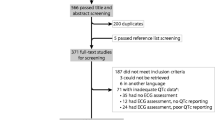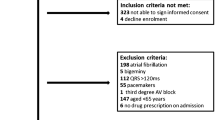Abstract
Rationale
A recent publication asserted that even low-dose risperidone may induce corrected QT (QTc) interval prolongation up to 500 ms without drug-induced IKr blockade. We seek to better understand the complexity of any link between risperidone-induced/associated QTc interval prolongation and torsade de pointes (TdP).
Objectives
The objective of this study is to systematically analyze all available case reports of risperidone, QTc interval prolongation, and/or TdP.
Method
We identify case reports using PubMed, Medline, EMBASE, and Cochrane.
Results
Of the 15 cases found, nine were adult women (ages 31, 33, 34, 37, 47, “elderly”, 77, 84, and 87 years) and one was a teenager. There were four men (ages 28, 29, 29, and 46 years) and one preadolescent boy. Besides risperidone administration or overdose, traditional risk factors for QTc interval prolongation and TdP included female sex (n = 10), older age (n = 4), heart disease (n = 3), hypokalemia (n = 2), bradycardia (n = 1), liver disease (n = 1), QTc interval prolonging drugs other than risperidone (n = 8), and metabolic inhibitors (n = 2). TdP occurred in four cases. Six patients died, and three deaths were probably related to TdP.
Conclusion
Risperidone (when properly prescribed in patients free of other risk factors for QTc interval prolongation and TdP) is a relatively safe drug. Conventional statistics can neither predict the individual patient who will experience TdP nor determine the relationship of drug dose to QTc interval prolongation and TdP. Narrative medicine using a case report format appears to be an alternative and valuable additional approach to advance our understanding of this relationship and to reduce risks.
Similar content being viewed by others
References
Bednar MM, Harrigan EP, Anziano RJ, Camm AJ, Ruskin JN (2001) The QT interval. Prog Cardiovasc Dis 43(5 Suppl 1):1–45
Bednar MM, Harrigan EP, Ruskin JN (2002) Torsades de pointes associated with nonantiarrhythmic drugs and observations on gender and QTc. Am J Cardiol 89:1316–1319
Beelen AP, Yeo KTJ, Lewis LD (2001) Asymptomatic QTc prolongation associated with quetiapine fumarate overdose in a patient being treated with risperidone. Hum Exp Toxicol 20:215–219
Blaschke D, Parwani AS, Huemer M, Rolf S, Boldt LH, Dietz R, Haverkamp W (2007) Torsade de pointes during combined treatment with risperidone and citalopram. Pharmacopsychiatry 40:294–295
Brown K, Levy H, Brenner C, Leffler S, Hamburg EL (1993) Overdose of risperidone. Ann Emerg Med 22:1908–1910
Cartwright AL, Wilby KJ, Corrigan S, Ensom MH (2013) Pharmacogenetics of risperidone: a systematic review of the clinical effects of CYP2D6 polymorphisms. Ann Pharmacother 47:350–360
Digby G, Machaalany J, Malik P, Methot M, Simpson CS, Redfearn D, Baranchuk A (2010) Multifactorial QT interval prolongation. Cardiol J 17:184–188
Digby GC, Perez Riera AR, Barbosa Barros R, Simpson CS, Redfearn DP, Methot M, Femenia F, Baranchuk A (2011) Acquired long QT interval: a case series of multifactorial QT prolongation. Clin Cardiol 34:577–582
Doyle M, Rosenthal LJ (2013) Psychotropic medications, associated QTc prolongation, and sudden cardiac death: a review for clinicians. Psychiatr Ann 43:58–65
Drolet B, Yang T, Daleau P, Roden DM, Turgeon J (2003) Risperidone prolongs cardiac repolarization by blocking the rapid component of the delayed rectifier potassium current. J Cardiovasc Pharmacol 41:934–947
Ereshefsky L, Lacombe S (1993) Pharmacological profile of risperidone. Can J Psychiatr 38(Suppl 3):S80–S88
Fossa AA, Wisialowski T, Wolfgang E, Wang E, Avery M, Raunig DL, Fermini B (2004) Differential effect of HERG blocking agents on cardiac electrical alternans in the guinea pig. Eur J Pharmacol 486:209–221
Gesell LB, Stephen M (1997) Toxicity following a single dose of risperidone for pediatric attention deficit hyperactivity disorder (ADHD). Clin Toxicol 35:549, Abstract #163
Gintant GA (2008) Preclinical torsades-de-pointes screens: advantages and limitations of surrogate and direct approaches in evaluating proarrhythmic risk. Pharmacol Ther 119:199–209
Hancox JC, McPate MJ, El Harchi A, Zhang YH (2008) The hERG potassium channel and hERG screening for drug-induced torsades de pointes. Pharmacol Ther 119:118–132
Harrigan EP, Miceli JJ, Anziano R, Watsky E, Reeves KR, Cutler NR, Sramek J, Shiovitz T, Middle M (2004) A randomized evaluation of the effects of six antipsychotic agents on QTc, in the absence and presence of metabolic inhibition. J Clin Psychopharmacol 24:62–69
Hii JT, Wyse DG, Gillis AM, Duff HJ, Solylo MA, Mitchell LB (1992) Precordial QT interval dispersion as a marker of torsade de pointes. Disparate effects of class Ia antiarrhythmic drugs and amiodarone. Circulation 86:1376–1382
Houltz B, DarpÖ B, Edvardsson N, BlomstrÖM PER, Brachmann J, Crijns HJGM, Jensen SM, Svernhage E, Vallin H, Swedberg K (1998) Electrocardiographic and clinical predictors of torsades de pointes induced by almokalant infusion in patients with chronic atrial fibrillation or flutter: a prospective study. Pacing Clin Electrophysiol 21:1044–1057
Indik JH, Pearson EC, Fried K, Woosley RL (2006) Bazett and Fridericia QT correction formulas interfere with measurement of drug-induced changes in QT interval. Hear Rhythm 3:1003–1007
Janssen Pharmaceutica (2009) Risperdal package insert. http://www.accessdata.fda.gov/drugsatfda_docs/label/2009/020272s056,020588s044,021346s033,021444s03lbl.pdf
Janssen Pharmaceutica (2012) Risperdal Consta package insert. http://www.risperdalconsta.com/sites/default/files/RisperdalConstaPI.pdf#zoom=100
Kang M, Lesh B, Tampi R, Fajobi O, Ruedrich S, Schubert D (2004) Spotting a silent killer. Current Psychiatry 3:75–88
Kogut C, Crouse EB, Vieweg WVR, Hasnain M, Baranchuk A, Digby G, Koneru JN, Fernandez A, Deshmukh A, Hancox JC, Pandurangi AK (2013) SSRIs and torsade de pointes: new concepts and new directions derived from a systematic review of case reports. Ther Adv Drug Saf (in press)
Kongsamut S, Kang J, Chen XL, Roehr J, Rampe D (2002) A comparison of the receptor binding and HERG channel affinities for a series of antipsychotic drugs. Eur J Pharmacol 450:37–41
Lazarczyk MJ, Bhuiyan ZA, Perrin N, Giannakopoulos P (2012) Selective acquired long QT syndrome (saLQTS) upon risperidone treatment. BMC Psychiatry 12:220
Marti V (2005) Sudden cardiac death due to risperidone therapy in a patient with possible hypertrophic cardiomyopathy. Ann Pharmacother 39:973
Megens AA, Awouters FH, Schotte A, Meert TF, Dugovic C, Niemegeers CJ, Leysen JE (1994) Survey on the pharmacodynamics of the new antipsychotic risperidone. Psychopharmacology (Berl) 114:9–23
Mok N-S, Tong C-K, Yuen H-C (2008) Concomitant-acquired long QT and Brugada syndromes associated with indapamide-induced hypokalemia and hyponatremia. PACE 31:772–775
Nandagopal JJ, Craig JM, Lippmann S (2003) QTc prolongation: possible association with risperidone and/or haloperidol. Psychosomatics 44:521
Panikkath R, Reinier K, Uy-Evanado A, Teodorescu C, Hattenhauer J, Mariani R, Gunson K, Jui J, Chugh SS (2011) Prolonged Tpeak-to-Tend interval on the resting ECG is associated with increased risk of sudden cardiac death. Circ Arrhythmia Electrophysiol 4:441–447
Pollak PT, Verjee ZH, Lyon AW (2011) Risperidone-induced QT prolongation following overdose correlates with serum drug concentration and resolves rapidly with no evidence of altered pharmacokinetics. J Clin Pharmacol 51:1112–1115
Poluzzi E, Raschi E, Moretti U, De Ponti F (2009) Drug-induced torsades de pointes: data mining of the public version of the FDA Adverse Event Reporting System (AERS). Pharmacoepidemiol Drug Saf 18:512–518
Postema PG, De Jong JSSG, Van der Bilt IAC, Wilde AAM (2008) Accurate electrocardiographic assessment of the QT interval: teach the tangent. Hear Rhythm 5:1015–1018
Rajabi F, Hajsheikholeslami F, Beyraghi N (2011) Sudden cardiac death after treatment with low dose risperidone in combination with cotrimoxazole. Asian J Psychiatry 4:218–220
Ravin DS, Levenson JW (1997) Fatal cardiac event followng initiation of risperidone therapy. Ann Pharmacother 31:867–870
Raviña R, Guteirrez J, Raviña P (2007) Acquired long QT syndrome: long-term electrocardiographic (Holter) recording of torsades de pointes ending in asystole: II. Int J Cardiol 116:272–275
Ritchie B, Norris ML (2009) QTc prolongation associated with atypical antipsychotic use in the treatment of adolescent-onset anorexia nervosa. J Can Acad Child Adolesc Psychiatry 18:60–63
Roden DM (1998) Taking the “idio” out of “idiosyncratic”: predicting torsades de pointes. Pacing Clin Electrophysiol 21:1029–1034
Roden DM (2004) Drug-induced prolongation of the QT interval. N Engl J Med 350:1013–1022
Sanguinetti MC, Mitcheson JS (2005) Predicting drug-hERG channel interactions that cause acquired long QT syndrome. Trends Pharmacol Sci 26:119–124
Sanguinetti MC, Tristani-Firouzi M (2006) hERG potassium channels and cardiac arrhythmia. Nature 440:463–469
Shah RR (2002) The significance of QT interval in drug development. Br J Clin Pharmacol 54:188–202
Shah RR (2004) Pharmacogenetic aspects of drug-induced torsade de pointes: potential tool for improving clinical drug development and prescribing. Drug Saf 27:145–172
Taleb NN (2010) The black swan, 2nd edn. Random House, New York
Tei Y, Morita T, Inoue S, Miyata H (2004) Torsades de pointes caused by a small dose of risperidone in a terminally ill cancer patient. Psychosomatics 45:450–451
Teodorescu C, Reinier K, Uy-Evanado A, Chugh H, Gunson K, Jui J, Chugh SS (2013) Antipsychotic drugs are associated with pulseless electrical activity: the Oregon Sudden Unexpected Death Study. Hear Rhythm 10:526–530
Titier K, Canal M, Déridet E, Abouelfath A, Gromb S, Molimard M, Moore N (2004) Determination of myocardium to plasma concentration ratios of five antipsychotic drugs: comparison with their ability to induce arrhythmia and sudden death in clinical practice. Toxicol Appl Pharmacol 199:52–60
Vieweg WV, Hasnain M, Howland RH, Hettema JM, Kogut C, Wood MA, Pandurangi AK (2012) Citalopram, QTc interval prolongation, and torsade de pointes. How should we apply the recent FDA ruling? Am J Med 125:859–868
Vieweg WVR (2003) New generation antipsychotic drugs and QTc interval prolongation. Prim Care Companion J Clin Psychiatry 5:205–215
Vieweg WVR, Hasnain M, Howland RH, Clausen T, Koneru JN, Kogut C, Breden E, Hancox JC, Fernandez A, Pandurangi AK (2013) Methadone, QTc interval prolongation, and torsade de pointes: case reports offer clinicians the best guidance for this problem. Ther Adv Psychopharmacol. doi:10.1177/2045125312469982
Vieweg WVR, Hasnain M, Wood MA, Fernandez A, Lesnefsky EJ, Pandurangi AK (2011) Cardiometabolic risks of antidepressant and antipsychotic drugs, part 1: proarrhythmic risks of antidepressant and antipsychotic drugs. Psychiatr Times 28(April):50–55
Vieweg WVR, Leadbetter RA (1997) Polydipsia–hyponatremia syndrome: epidemiology, clinical features, and treatment. CNS Drugs 7:121–138
Vieweg WVR, Schneider RK, Wood MA (2005) Torsade de pointes in a patient with complex medical and psychiatric conditions receiving low-dose quetiapine. Acta Psychiatr Scand 112:319–323
Vieweg WVR, Wood MA (2004) Tricyclic antidepressants, QT interval prolongation, and torsade de pointes. Psychosomatics 45:371–377
Vieweg WVR, Wood MA, Fernandez A, Beatty-Brooks M, Hasnain M, Pandurangi AK (2009) Proarrhythmic risk with antipsychotic and antidepressant drugs: implications in the elderly. Drugs Aging 26:997–1012
Vigneault P, Kaddar N, Bourgault S, Caillier B, Pilote S, Patoine D, Simard C, Drolet B (2011) Prolongation of cardiac ventricular repolarization under paliperidone: how and how much? J Cardiovasc Pharmacol 57:690–695
Viskin S, Rosovski U, Sands AJ, Chen E, Kistler PM, Kalman JM, Chavez LR, Torres PI, Cruz FES, Centuri¢n OA, Fujiki A, Maury P, Chen X, Krahn AD, Roithinger F, Zhang L, Vincent GM, Zeltser D (2005) Inaccurate electrocardiographic interpretation of long QT: the majority of physicians cannot recognize a long QT when they see one. Hear Rhythm 2:569–574
Yamaguchi M, Shimizu M, Ino H, Terai H, Uchiyama K, Oe K, Mabuchi T, Konno T, Kaneda T, Mabuchi H (2003) T wave peak-to-end interval and QT dispersion in acquired long QT syndrome: a new index for arrhythmogenicity. Clin Sci (London) 105:671–676
Yap YG, Camm AJ (2003) Drug induced QT prolongation and torsades de pointes. Heart 89:1363–1372
Zarate CA Jr, Baldessarini RJ, Siegel AJ, Nakamura A, McDonald J, Muir-Hutchinson LA, Cherkerzian T, Tohen M (1997) Risperidone in the elderly: a pharmacoepidemiologic study. J Clin Psychiatry 58:311–317
Zhang L, Timothy KW, Vincent GM, Lehmann MH, Fox J, Giuli LC, Shen J, Splawski I, Priori SG, Compton SJ, Yanowitz F, Benhorin J, Moss AJ, Schwartz PJ, Robinson JL, Wang Q, Zareba W, Keating MT, Towbin JA, Napolitano C, Medina A (2000) Spectrum of ST-T–wave patterns and repolarization parameters in congenital long-QT syndrome: ECG findings identify genotypes. Circulation 102:2849–2855
Conflict of interest
No author has a conflict of interest, and no funding was involved in the preparation of this paper.
Author information
Authors and Affiliations
Corresponding author
Rights and permissions
About this article
Cite this article
Vieweg, W.V.R., Hasnain, M., Hancox, J.C. et al. Risperidone, QTc interval prolongation, and torsade de pointes: a systematic review of case reports. Psychopharmacology 228, 515–524 (2013). https://doi.org/10.1007/s00213-013-3192-8
Received:
Accepted:
Published:
Issue Date:
DOI: https://doi.org/10.1007/s00213-013-3192-8




